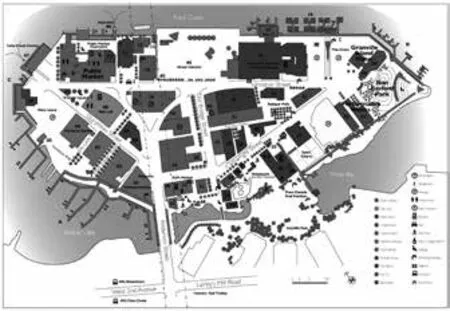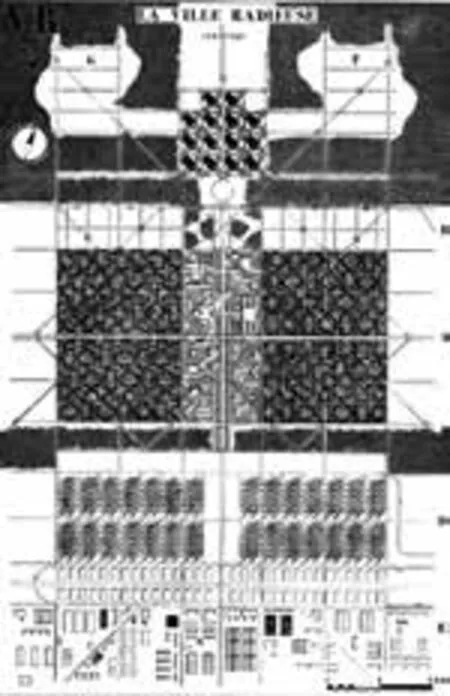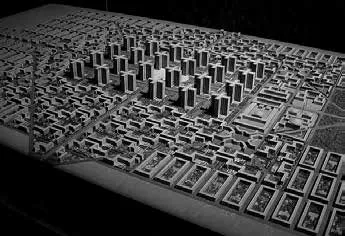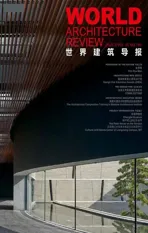城市建筑主义+建筑城市主义
2020-07-14刘廷杰
文/刘廷杰
by Tingjie (Peter) Liu
城市及其建筑物传记的内容相当明确,它自身丰富的乐趣和想象力正是来源于城市的建筑实体.并且最终由建筑物和情感组成的结构中叙述着城市。(阿尔多.罗西, «城市建筑学»P21,中国建筑工业出版社)
The biographical content of the city and its buildings is quiet obvious that its abundance of pleasure and imagination are from itself building entities, and ultimately narrates the city in a structure composed by buildings and emotions.(Aldo Rossi, The Architecture of the City, P21,China Architecture & Building Press)

物质的城市city,承载了人群的生活方式形成Urbanity。“城市”给人的第一感觉是物质的建筑空间;其次是空间背后的生活方式。这是城市的递进二元性,是不可切割的绑定和必然相关性。讨论城市就必然讨论建筑和生活方式主义。
物质城市所展现的city form自然反映了与生活方式关联的历史、世俗、资本、交通、人工建筑等可以归咎为形而上的东西。而可见物质最基本的单位就是建筑物。城市的功能性、运转、有机和严密,与建筑物的功能性、完成性、可建造性、美学偶然性、似乎可以对应。在物质城市的建造过程中,建筑物的不断建造和聚集是得以使纸面规划和城市按理想主义实施的唯一方式。Alex Kriger说“物质城市总是成为一个改变的催化剂(Alex Kriger, The American City: Ideal and Mythic Aspects of A Reinvented Urbanism,Assemblage3, 1987)。”而建筑物显然是这催化剂中的催化剂。这种城市对建筑的依赖,被催化以及与建筑的类同性,或更简单得称着城市的建筑性,可以称着城市建筑主义--以建筑的方式设计城市。
另一方面,承载着独特生活方式的城市在现代的发展正将反映现代生活方式的模式演绎成一种风尚,就是城市主义。城市主义以关怀人的生活方式为基础,关注交通可抵达、城市空间平等享有的权力,社会关系之间的信任和尊重,城市可持续性发展和更新,尊重历史和遗产等客观和理想议题。处在这一城市发展网络中的建筑必须做到左顾右盼,必须遵守城市发展法则。Ego Architecture与城市文脉分离,与城市主义背道而驰会受到批判。建筑必须更聪明地面对城市可持续性的发展和生活方式主义的人本需求。这就是建筑城市主义,或者说建筑必须与城市理想主义绑定、建筑必然承担城市理想主义的压力和血脉关联。
古希腊雅典卫城是典型建筑群的艺术组合。建筑组合虽自由,但比例高大,柱式更具崇高感,使建筑群态的祭奠感和仪式感达到极高的地位。中世纪的文艺复兴城市和以后的巴洛克城市,通过城市轮廓的几何构成(园的、长方的或其它形式)也表现了强大的中心仪式感。建筑具有完成城市中心仪式感和纪念性的强大填充作用,当时的建筑学也具有崇高地位。从古典城市到文艺复兴城市,建筑学或城市建筑主义地位极端崇高,可以说城市就是建筑。在现代城市结构性衰落地区的复兴中,建筑也起了重要作用。这些复兴工程通过挖掘建筑的历史和观景价值、结合新型产业的导入完成区域的城市复兴,著名的有加拿大温哥华的Granville Island改造和Yell Town改造、澳大利亚悉尼的Walsh bay改造等。无论传统仪式城市和现代城市中心的复兴计划,建筑既是城市的工具又成为城市的主体或成为城市自己。正如Mario Gandelesonas 形容的 “Architecture inhabits the City”,建筑占据城市。(Mario Gandelsonas, X-Urbanism, Princeton Architectural Press,1999)

加拿大格兰弗岛 Granville_Island_Map

硅谷 Silicon Valley

新城市主义社区和街道Community and Street Planning of New Urbanism

工业化之后的西方城市,典型的如美国的网格城市、超高层城市、现代主义城市、郊区城市和边缘城市等。工业化和高速公路的发展,极大改变了城市的交通方式,而人的生活方式得以根本改变。城市版图和形式不再暗示中世纪的机理和中心主义,而是起始于工业文明的召唤和理想。柯布西耶的光辉城市理论和实践以立体的交通网、大片绿地、开放空间,将城市不同功能自内而外联系起来。中心城区规划低密度高层居住建筑群,郊区则按田园城镇规划。虽然这一乌托邦神话被西方社会批判为割裂了交流,但显然柯布已尝试用全新的规划格局来适应工业文明下均质生活方式的需求,具有城市主义关怀。西方工业文明晚期的郊区城市、边缘城市,是反中心城市扩张的。开放绿带和高速公路连接了郊区和中心城市的联系;x-urban城市更具有较完整的城市二级功能。这些新型城市的产生应对了人群生活方式的变化,具有可持续性发展的理念。这一城市格局下的建筑群必须顺应城市发展的要求,建筑从城市主体转换为均质配角。正如Mario Gandelesonas 形容的 “The City inhabits Architecture”,城市占据建筑。(Mario Gandelsonas,X-Urbanism, Princeton Architectural Press,1999)
虽然建筑主义在古典城市、文艺复兴城市现代城市更新计划中占据主体;城市主义在工业文明及以后的新型城市实践中占据主体,然而显然城市复杂性将建筑和城市这两种主客体或客主体互为绑定。城市建筑主义和建筑城市主义是一个双向法则,无论是城市隐藏在建筑之后或建筑隐藏在城市之后,目标都是试图通过秩序、美学、尊重和履行尽职来建立建筑和生活方式主义之间的连接和亲密关系。

纽约 New York Model

阿道夫卢斯芝加哥论坛报竞赛Adolf Loos Chicago Tribune Competition Entry, 1922

克莱斯勒Chrysler Building
Physical cities bear the citizens' daily life and form the theory of urbanity. The first impression that 'city' gives people is that the physical building spaces. In addition, it will be people's daily routines behind the buildings. These two facts reflect the urban duality, which is a solid binding and an inevitable relation. Therefore, it is necessary to discuss both architecture and lifestyle principle when we deal with cities.
The physical form of a city naturally reflects the relations with its history, customs,capital, transportation,artificial buildings etc, which could be summarized as a metaphysical concept. Among those characters, a building is a very basic visible unit. As a city's functionality, running efficiency, organic characteristics and rigor etc seem to be similarly with building's functionality, integrity, buildability and aesthetic contingency as so on. During the construction progress of a physical city,it is the only path that the city is continually raised and assembled by buildings to implement the master plan in-paper and urban idealism. Alex Kriger said, The city, of course, has been a great catalyst of change (Alex Kriger, the America City,Ideal and Mythic Aspects of A Reinvented Urbanism, Assemblage 3, 1987)'. And obviously, architecture is one of the most important catalytic. This dependency,catalytic and homogeneity of urbanity to buildings, that we can simply understand as architectural features, are named as “Architecturism of Urbanity --Designing a city by Architecture”.
The city bearing the unique lifestyle under the contemporary development is transforming the model of reflecting the modern life to fashion, which is defined as urbanism. Urbanism takes care of lifestyle, transportation accessibility, right of sharing urban spaces, trust and respecting each other among the social relations,sustainable urban renewal, heritage issues and ideology etc.. Architecture among in a city’s network has to look around and has to follow the guide of the city’s development. Ego architecture which separates from the city’s context and against urbanism will be disputed. Architecture has to confront the needs of urban sustainable development , has to bound with urban idealism and undertake the pressure of context. This is named as “Urbanism of Architecture--Designing architecture with Urbanity”.
The ancient Greek Acropolis is a typically artistic representation. The building group is organically combined while the proportion is huge. The Greek columns make the group memorial and ritual in particular.
The Renaissance cities in the late Middle Ages and Baroque Cities afterwards formed by a geometric layout (circular, rectangle or other forms) presented a strong sense of center ceremony. Architecture has a powerful filling effect with those central memory and ritual. Architecture or Architecturism occupied a high status.The conclusion might be made that Urbanity is Architecture.
At the urban revival areas where urban structure is declining in the modern cities,architecture is also playing a key role. By mining the architectural history and value,and combining with the updated industrials, architecture finishes the urban revival.There are many projects such as Granville Island in Vancouver, and Walsh Bay Revitalization in Sydney well-known. Whether the traditional ceremony cities or revitalization of modern cities, architecture is not only the main tool of the city but becomes the city itself. As Mario Gandelesonas described in “Architecture inhabits the City.”(Mario Gandelsonas, X-Urbanism, Princeton Architecture Press, 1999)
The Western cities after 2nd world war, typically such as American Grid City,Skyscraper City, Modern City, Suburban City and Edge City etc.. were fundamentally changed by highway network and industrialization. Therefore the transportation system and lifestyle were changed as well. The urban layout and form no longer indicates medieval mechanism and centralism, but roots in industrial civilization and idealism. Le Corbusier’s theory and practice of Radiant City built a homogeneous society with the 3Dimentional traffic network, large green spaces, high-rise residential quarters with low density. Although this utopian mythology was criticized by westerns as separating social communication, Le Corbusier has experimented with new planning pattern to adapt the demands of the homogeneous life under industrial civilization, which displayed urban care.
Suburban City emerged since 1950’s and Edge City emerged since 1970’s link the suburbs and city centers by green belts and highway networks. New urban patterns and sustainable principles impact those new cities. Architecture consequently has to meet the guidance of new urbanism by transferring a leading role to a supporting role. As Mario Gandelesonas described as “The City inhabits Architecture”.(Mario Gandelsonas X-Urbanism, Princeton Architecture Press, 1999).
Although the architecturism occupies the cities in the classical cities, renaissance cities and modern city revitalization as so on, and urbanism occupies the cities in post industrial cities, architecturaism and urbanism these two subject or object or reversed are bound each other in such complicated urban environments now. Urban architecturism and Architectural urbanism which means either city hidden in the architecture or architecture hidden in the city are eager to build intimate connections by order, aesthetics, respect and performance.




柯布西耶的光辉城市(巴黎) The Radiant City of Le Corbusier
